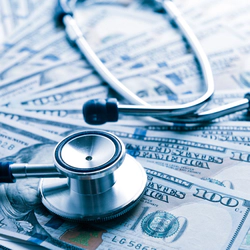Treating Addiction Provides Lasting Economic Benefits
Returning productive members of society back to the workforce is an often overlooked benefit of treating addiction.

An April 28th article by Dr. Nora Volkow, director of the National Institute on Drug Abuse, focused on the economic benefits of addiction prevention and treatment. The broader financial benefit of Americans overcoming drug addiction is rarely talked about, but in light of recent economic struggles that virtually all Americans are experiencing, Dr. Volkow’s article could not have been more timely.1
Dr. Volkow presents two key points:
- Addiction is an expensive public health crisis.
- Treating addiction (or preventing it) is economically beneficial.
Truly, preventing and treating addiction has the potential benefit of improving the economy.
Addiction is an Expensive Public Health Crisis

It does not take an active imagination to think up ways addiction can be costly to society. According to the Office of National Drug Control Policy, the economic cost of drug abuse rings to the tune of $193 billion, and that’s a conservative estimate.2 Most of that cost is in reduced productivity due to lost labor participation ($120 billion). Healthcare costs are a significant factor ($11 billion) as are criminal justice costs ($61 billion).
And that’s just drug abuse. According to the National Institute on Alcohol Abuse and Alcoholism, alcohol abuse costs the nation about $249 billion per year.3 Again, these are conservative estimates, with some experts believing the combined financial toll of drug and alcohol abuse in America reaches over half a trillion U.S. dollars each year.
Beyond the sheer dollar amount in costs incurred from drug and alcohol addiction, there are other factors to consider, all of which act as drags on the economy. Turnover, work absenteeism, school drop-out, poor productivity in the workplace, workman’s comp applications, missed college degrees due to failed exams, and other factors connected to substance abuse harm the economy, even if such harm is more difficult to measure in dollar amounts.
Treating Addiction (and Preventing it) is Beneficial to the Economy
It’s challenging to measure a broader financial return on investment with something as widespread and complex as addiction. However, when public health officials implement treatment approaches within their communities and then measure financial results, one can see the potential benefit of a nationwide effort to treat addiction.
A case in point is a group of researchers who studied various projects run by the Communities That Care program.4 This public health organization seeks to help communities utilize resources to address substance abuse problems in youth more effectively. According to the analysis, an approximate $602 investment in each child and teen involved in the program yielded an estimated $7,754 in savings by the time participants were age 23. That’s a $12.88 return for each dollar invested. Such savings are distributed among individuals, families, taxpayers, and other stakeholders; savings being measured by what the community did not have to pay in criminal justice fees, policing, monitoring, halfway house programs, and other costly interventions that result when drug abuse prevention is not utilized with at-risk youth.
“Every dollar invested in addiction treatment programs yields a return of between $4 and $7 in reduced drug-related crime, criminal justice costs, and theft.”

Beyond prevention efforts, there is data showing how investments in treating those addicted to drugs and alcohol are also financially sensible. NIDA has published extensively on this, with one bit of research5 laying out clear statistics on what happens, financially, when investments are made in addiction treatment: “Every dollar invested in addiction treatment programs yields a return of between $4 and $7 in reduced drug-related crime, criminal justice costs, and theft. When savings related to healthcare are included, total savings can exceed costs by a ratio of 12 to 1. Major savings to the individual and society also stem from fewer interpersonal conflicts; greater workplace productivity; and fewer drug-related accidents, including overdoses and deaths.” The list goes on, and as mentioned earlier, it’s almost impossible to calculate just how much is saved by treating addicts and helping them get clean because doing so unlocks every recovered individual’s potential, enabling them to rejoin the workforce and potentially innovate stunning advancements, ideas, and achievements.
Looking at another example of addiction treatment benefiting a local community, a study in California found that 70% of the estimated costs of alcohol abuse in one area could be attributed to lost productivity (alcohol-addicted employees not being able to work due to their addiction).6 That study suggested because most of the addiction’s toll on the economy comes down to lost productivity employers are vested stakeholders in ensuring employees get addiction treatment. And to that point, the California study found that for every 60 days of substance abuse treatment services that were delivered to employed alcohol addicts, about $8,200 was saved in healthcare and productivity costs.
Last but not least, there are significant savings achieved when addicts get treatment, not just in the form of productivity and healthcare savings, but also in criminal justice savings. The above-cited study found that addicts who receive qualified drug treatment are 16% less likely to be arrested and 34% less likely to be convicted of a felony, effectively contributing considerable cost-savings in criminal justice expenses that would have otherwise been levied on the taxpayer.
Addiction Treatment: Solving the Problem for One and All
From healthcare costs to lost workplace productivity, criminal justice costs to collateral damage and academic underachievement, the issue of millions of Americans addicted to drugs and alcohol has severely harmful effects on the national economy and all those who live and work in it.
Helping those who are addicted get into and through drug and alcohol rehab programs, on the other hand, would improve the economy, revitalize an important sector of the labor force, reduce workplace costs, potentially reduce tax dollars spent on criminal justice, and generally improve the lives of not just addicts, but their families too.
If you are a business owner and one of your employees is addicted to drugs and alcohol, please help them enter a drug and alcohol rehab center. It’s not just the right thing to do for your employee but ensuring they get treatment and reenter the workforce as a drug-free individual is the right thing to do for your business and the economy.
Sources:
-
NIDA. “Investing in Prevention Makes Good Financial Sense.” 2022. nida.nih.gov ↩︎
-
Office of National Drug Control Policy. “How Illicit Drug Use Affects Business and the Economy.” 2012. obamawhitehouse.archives.gov ↩︎
-
NIAAA. “Alcohol Facts and Statistics.” 2022. niaaa.nih.gov ↩︎
-
NIH. “Long-term Impacts and Benefit-Cost Analysis of the Communities That Care Prevention System at Age 23, 12 Years After Baseline.” 2021. pubmed.ncbi.nlm.nih.gov ↩︎
-
NIDA. “Principles of Drug Addiction Treatment: A Research-Based Guide.” National Institute of Drug Abuse, 2012. nida.nih.gov ↩︎
-
Office of National Drug Control Policy. “Cost Benefits of Investing Early In Substance Abuse Treatment.” 2012. obamawhitehouse.archives.gov ↩︎







 ®
®